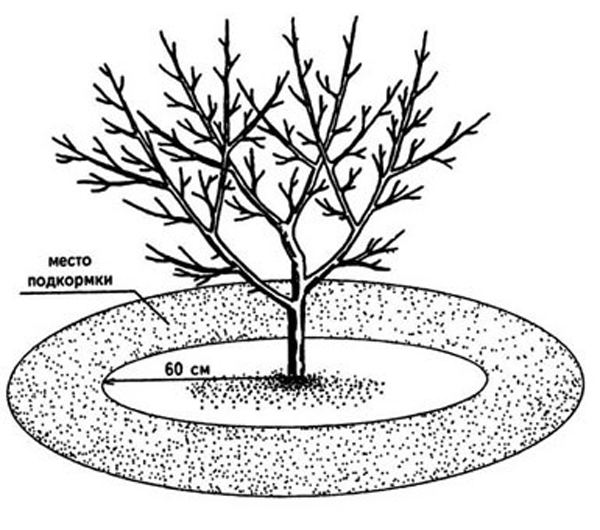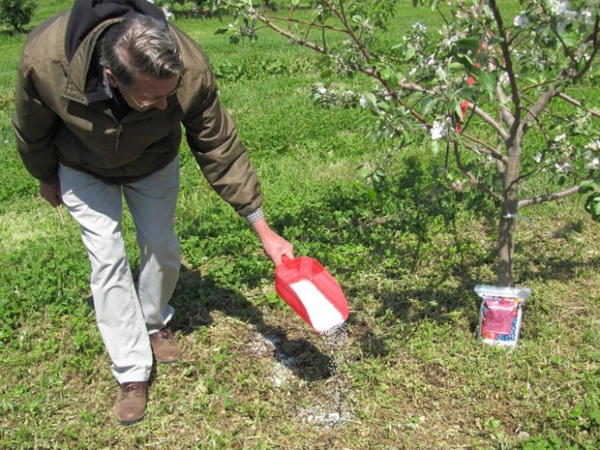Spring feeding of apple trees is a guarantee of a good harvest
With the onset of spring, all living things awaken. The first buds begin to appear on the trees in your garden, everything is blooming and fragrant. But do not waste time in vain, because trees need proper and timely nutrition. The article will tell you how to feed apple trees in spring and how to do it most effectively. Indeed, their development and yield depend on the timely and correct feeding of the apple tree in the spring.
Content
Feeding rules
Garden trees need to be fertilized periodically throughout the year. The first feeding is carried out in early spring, when young leaves are just appearing on the apple tree. Trees are coming out of dormancy and need to replenish resources after winter. Most of the nutrients trees get from the earth, water and air, however, minerals are not always available in the required amount. And even more so in the spring the trees need additional nutrition. However, everything needs a measure - an excess of nutrients is just as dangerous as their lack. If you oversaturate a young apple tree, for example, with nitrogen, which affects the growth of shoots, you get a large tree with many shoots, but no fruit.
Fertilizing gardens in spring, amateur gardeners in their practice use 2 types of fertilizers: mineral (nitrogen, potash, micronutrient fertilizers) and organic (compost, slurry, manure).
When choosing a mineral feed, proceed from what type of soil you have in your summer cottage. It is advisable to give the tree those elements that it cannot take in sufficient quantities from the soil. If the soil is sandy, and accordingly there is little nitrogen in it, it will be most rational to fertilize it with nitrogen-containing fertilizers.
But with black earth, things are different. It is rich in nitrogen and does not need nitrogen treatment.
Fertilizers should be applied not only under the tree, but also at a distance of half a meter from the crown. Thanks to its root system, the apple tree will assimilate them even at such a distance. To know exactly how many minerals a particular tree needs, a simple calculation can be made. We need to find the area in square meters to fertilize. It is simple to determine it: measure the diameter of the crown, add one to it and multiply the result by 3.14. Then we multiply the resulting number by the amount required to fertilize 1 square meter (usually it is written on the packages).

Scheme of spring feeding of apple trees
An important role in determining the required amount of beneficial nutrients is played by the degree of soil moisture. If the apple tree is properly watered and its soil is sufficiently moistened, then you can add flavoring substances in large doses. Combining the right watering with the right dose of nutrients will give you a bountiful harvest.
Remember that in wet and rainy weather, fertilizer should be added undiluted (dry). Just scatter the substance of your choice around the tree, and it will fall on the roots with rainwater.
In addition to root feeding, foliar feeding can also be used. Thanks to this method, the apple tree will receive the necessary nutrients directly through the leaves. It is carried out by spraying the crown. Remember that spraying is best done early in the morning, before the sun has risen or after sunset, in the evening. If it is cloudy, then this procedure can be carried out during the day. After all, it takes time for the leaves to absorb the nutrient solution, but under the influence of sunlight it will quickly evaporate and we will not achieve the expected effect. Follow the recommendations while spraying.It is not necessary to prepare and use high concentration solutions. Their use leads to leaf burns.
Fertilizer selection
With the onset of spring, apple trees need fertilizers, which contribute to the processes of flowering and the formation of ovaries. From minerals, gardeners use nitrogen-containing ones, and from organic ones, they introduce manure, compost and bird droppings in the spring.
Organic
A good spring feed is the mullein. The required amount of manure is 4–8 kg per 1 square meter. m of soil. With its regular use, it is possible to achieve an improvement in the structure of the soil. Sandy soils begin to retain moisture better, while clay soils become loose and lighter.
Bird droppings can be applied dry or diluted with water. Before adding dry bird droppings to the soil, it must be crushed. If it is necessary to dilute with water, then the proportion should be as follows: 1 part of droppings to 15 parts of liquid. The resulting solution should be fertilized immediately and should not be left in reserve.
Compost is made from dry sawdust, leaves and all kinds of waste. Thanks to organic matter, the soil is saturated with many nutrients necessary for the plant, and its structure also changes: the soil becomes loose, it allows water to pass through better.
Mineral
These include nitrogen-containing flavoring agents: potassium sulfate, ammonium sulfate, as well as micronutrient fertilizers.
Each type contains a certain amount of an active element, which is usually indicated on the packaging in the form of symbols from the Periodic Table (for example, N-nitrogen, K-potassium). As a rule, trees are partially assimilated minerals.
Nitrogen fertilizers affect the yield. They must be brought in in early spring. With a lack of nitrogen, the quality of the fruit will decrease. For Apple, 12 g of this element per 1 square meter is enough. m area. Ammonium nitrate contains up to 35 percent nitrogen. Fertilizing the soil, you need up to 30 g of this substance per 1 sq. m. And if we want to fertilize a young garden with liquid fertilizing, then only 20 g of saltpeter is enough for a bucket of water.

Potassium sulfate is rightfully considered one of the best potash fertilizers for feeding an apple tree, because it contains up to 46 percent of potassium. It promotes active growth and better fruiting of the apple tree. If we carry out top dressing, 10 g per 1 sq. m, and for the main fertilization process, you need to take 25 g.
Ammonium sulfate, which affects the quality of the future harvest, is perfectly preserved in the soil and is not washed out of it for a long time. Based on this, it is advised to bring it in both spring and autumn. For feeding, 25 g per 1 sq. m, and for the main method of fertilization - up to 50 g.
Microfertilizers help fight fungal diseases, improve the quality of fruits.
Now you know why and how you need to properly fertilize the land on your site. This means that your garden will receive all the necessary nutrients and will actively bear fruit.
